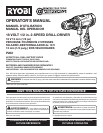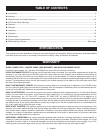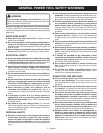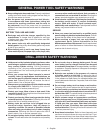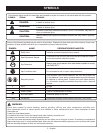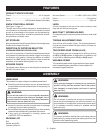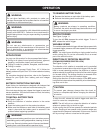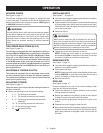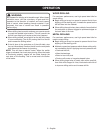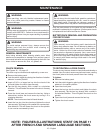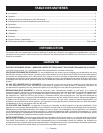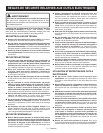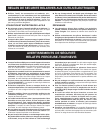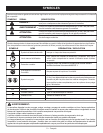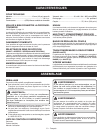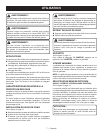
9 – English
OPERATION
WARNING:
Be prepared for binding at bit breakthrough. When these
situations occur, drill has a tendency to grab and kick
opposite to the direction of rotation and could cause
loss of control when breaking through material. If not
prepared, this loss of control can result in possible
serious injury.
When drilling hard, smooth surfaces, use a center punch
to mark the desired hole location. This will prevent the
drill bit from slipping off-center as the hole is started.
When drilling metals, use a light oil on the drill bit to keep
it from overheating. The oil will prolong the life of the bit
and increase the drilling action.
If the bit jams in the workpiece or if the drill stalls, stop
the tool immediately. Remove the bit from the workpiece
and determine the reason for jamming.
NOTE: This drill has an electric brake. When the switch
trigger is released, the chuck stops turning. When the brake
is functioning properly, sparks will be visible through the
vent slots on the housing. This is normal and is the action
of the brake.
WOOD DRILLING
For maximum performance, use high speed steel bits for
wooddrilling.
Begin drilling at a very low speed to prevent the bit from
slipping off the starting point. Increase the speed as the
drillbitbitesintothematerial.
When drilling through holes, place a block of wood behind
the workpiece to prevent ragged or splintered edges on
thebacksideofthehole.
METAL DRILLING
For maximum performance, use high speed steel bits for
metal or steel drilling.
Begin drilling at a very low speed to prevent the bit from
slippingoffthestartingpoint.
Maintain a speed and pressure which allows cutting with-
out overheating the bit. Applying too much pressure will:
•Overheatthedrill;
•Wearthebearings;
•Bendorburnbits;and
•Produceoff-centerorirregular-shapedholes.
When drilling large holes in metal, start with a small bit,
then finish with a larger bit. Also, lubricate the bit with oil
to improve drilling action and increase bit life.



